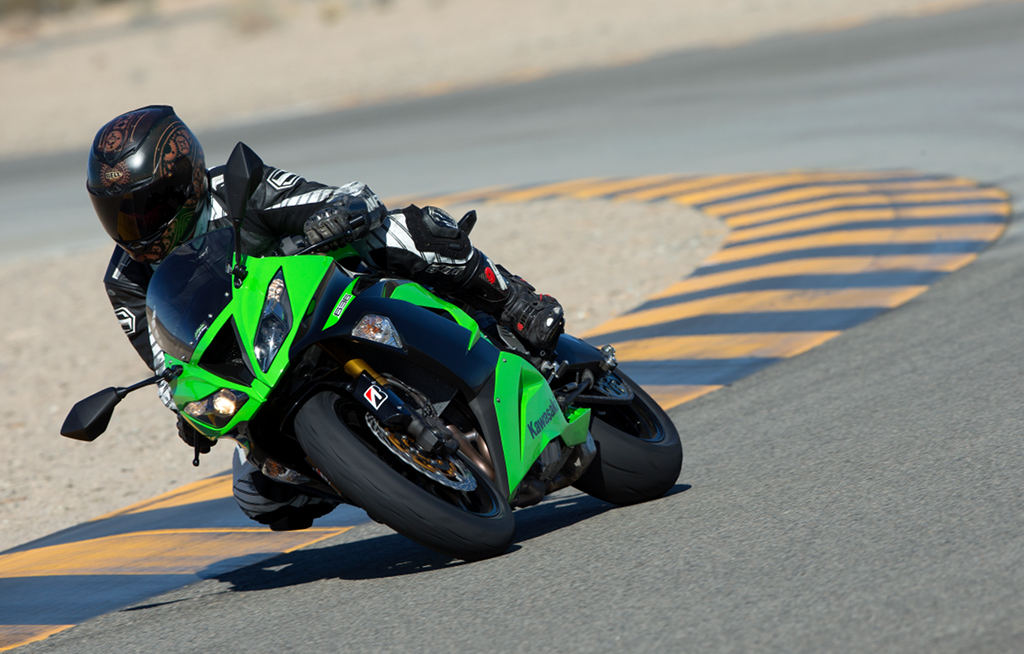I got a call from Dirck about attending a “for the fun of it” track day that Kawasaki would be putting on out at Chuckwalla Valley Raceway here in the Southern California desert. Almost before the last word was spoken, I had jumped ‘all in’, since I hadn’t been on a track for awhile on a four-stroke. “Great!”, Dirck replied, “I’ll forward their invite to you and RSVP that you are attending”.
I was stoked, because I would finally get to ride Chuckwalla’s well liked race track, and Kawasaki would have their entire sport bike lineup available to sample at our discretion throughout the day. A couple days later, I checked the weather for that area, and realized that it’s gonna be cold, with a forecast of 30 in the a.m., warming to a high of maybe 50 for the day, and probably windy, for a good dose of wind chill. I casually mention to Dirck my haste in agreeing to the gig before realizing how cold it would be, for both myself and my tires, and, being the knowing, compassionate mentor he is, Dirck replies “Don’t be a p***y!”, and so, off to the track I go….
I pull up to the office at CVR to sign in, it’s 7:15 a.m. and the thermometer on the rearview mirror of the truck reads 27 degrees. I know some of our readership is up to their eyeballs in snow, sub zero temperatures, wind chill factors that are sub-sub zero, and all that, so I won’t talk about it being cold…as much…
I arrived as the Kawis were being unloaded and staged. Multiple examples of the Ninja 300, Ninja 650, ZX-6R (with 636cc on board), and ZX-10R were lined up in rows and fueled, along with a check of pressures for the newly mounted Bridgestone BT 003 Race Street tires. Now 34 degrees, nary a generator, power strip, or tire warmer was to be seen. The intended relaxed nature of the event could be read after seeing turn signals and mirrors still in place, but taped over. Repeated reminders from Brad Puetz and the Kawasaki staff about the tires being new, unscrubbed, and not even close to being warm were heard. I took that to mean they really didn’t want to use the crash truck. Several laps to warm the tires would be the order of the day. The mercury sluggishly rises, and there’s a welcome delay until nearer 10 a.m. while the track is cleared of a layer of desert sand. The track is deemed hot – as in “active”…. Brad takes an exploratory lap on his ZX-10R before returning to lead the collection of journalists out for a few familiarization laps.
I decided on the Ninja 650 to get me around for the first session at this new to me track. It’s less intense than either the ZX-6R, or ZX-10R, but still capable of respectable speed when pushed. After the supervised laps were done, Brad turned us loose. This being my first visit to CVR, I was far from being on the optimum line, so I’d wave a rider by, then drop in for a tow for a few corners to get a look at the line they were using. Using this as a learning method, I would eventually be able to string together a few laps competently in the afternoon sessions and avoid the shame of a ride to the pits in the crash truck.
Back to the 650. This was my first experience with this model. As I previously mentioned, it has a relaxed seating position, a little too relaxed for my liking. The handlebars also put my hands at an angle I’m not accustomed to, having spent almost all of my riding life on sport bikes. It would be an easy, and cheap fix to replace the handlebars with a bend more to my liking, something that I can’t say about my beloved sport bike, since I personally just went through handlebar replacement on my own steed. The seat – peg – handlebar relationship felt very good, a far cry from the tucked in, folded up attitude of the 6R & 10R. The 650 twin was a flexible, accommodating mill that served up exactly what was asked for at the throttle. Progress through the rev range was more enthusiastic, less frantic. Typical of Kawasaki engines, it minded not a bit spending all of its time with the tach needle at, or a little past redline. Drive out of a corner at lower than optimum revs revealed an engine with excellent drivability and respectable torque. Since I race a two-stroke, all this engine braking was taking some adjustment time. The 650 doesn’t have a slipper clutch, and so I needed to modulate clutch engagement manually at the left hand. Problem solved. Vibration was present, but subdued. As long as I was paying clos(er) attention to my shifting technique, rowing up and down the gearbox went smoothly. If I got a little sloppy, or inattentive with my left foot, the shift action would become notchy and a little reluctant. This issue could also be partially explained by the long travel throttle, as I’m used to much quicker action throttles. Braking was adequate. They felt a little wooden, and required a good squeeze after confidence in my lines and grip levels improved, but never faded. Overall handling of the 650 was smooth, predictable, and somewhat leisurely in left- right transitions. The suspension, on standard settings, acquitted itself well, keeping excess movement from becoming a problem. A smooth rider could really hustle this bike around CVR. The 650 was a good ambassador, being a good tour guide of CVR.
Next came the smallest Ninja, the new 300. Like the 650, we’ve covered it in detail during previous test sessions, so I’ll not burden you with spec sheet specifics. After the 650, the 300 felt toy like in size and weight. Ergonomically speaking, it was quite versatile in the way it allowed the rider to tool around like a street commuter, or do the Moto3 imitation tuck. The little engine that could, and in fact did, build excellent velocity at the end of CVR’s short straightaways. Engine braking was not an issue on this model, those twin, 148cc pistons don’t put up much of a fight on closed throttle. Shifting was very good, with most of that being done exiting and entering the pits. Out on the track, shifting happened only a couple times per lap. Drivability wasn’t something that was an issue, since, despite the track’s semi tight, technical nature, the throttle was more like a switch with this little scythe. The brakes left something to be desired. This is surprising, since I’ve always lauded Kawasaki’s stoppers on all the other sport bikes of theirs I’ve tested. I suspect it’s due to the largely novice clientele this bike attracts that makes less aggressive brake action a more prudent choice in this product’s behavior. Handling is quick, and light but predictable and reassuring. Riding a bike this size is an exercise in temperance and smoothness, since its small size and absence of weight don’t require the control inputs or weight shifts of the larger bikes to change direction. Less is more with this bike.
Onto the ZX-6R. Now (again, actually) displacing 636cc, this model has evolved considerably from the two previous iterations I’ve ridden, as the march of time, and competition on the track and in the showroom would dictate. As expected, ergonomics are no nonsense, but still less aggressive than the Yamaha R6, and everything about the 6R is tighter, more precise, more responsive, and more powerful than on the 650 and 300, and indeed, previous versions of itself. Born out of race track competition in production class rule structures, Kawasaki has adorned the 6R with rider aids in the form of ABS, power modes, and 3 mode traction control, while bucking the production class displacement constraint with the added 36cc. I left the engine in full power mode, and selected traction mode 2, with the track and tires being somewhat chilly still. The overall friendly, leisurely feel of the 650 & 300 had been replaced with the committed, serious feel of a special ops soldier. Competence and precision are rewarded, but less committed riders are tolerated without complaint. The engine simply is a jewel. You could forgive an engine that redlines at 16,000 rpm if it was soft below, say, 10,000 rpm, but the extra capacity makes this much less of an issue, perhaps a non-issue. Supreme flexibility and drivability are hallmarks of this mill. Naturally, the real fun resides between 11,000 and 16,000 rpm. Wide open throttle over a rise in 4th gear sees the front wheel clear of the pavement if your face shield isn’t very close to or touching the edge of the windscreen. Lots of fun. Shift action is light, smooth, and quick. Rear wheel hop is kept in check by the slipper clutch. The brakes of the 636 are what I remember of Kawasaki anchors, only better now. Great power and feel from the monobloc calipers. Handling is what you’d expect of something that populates professional racing grids around the world. The suspension of the first 636 unit I rode was notably soft, particularly the forks, which allowed this particular 6R to dive excessively on the brakes-not a characteristic of a big piston fork. I was puzzled, and not comfortable with this, and discussed it at the end of the session with the crew for adjustments.
Time for lunch! Like locusts on fresh crops, the collective of journalists descended upon the lunch offerings of bbq chicken, bbq pulled pork and tri-tip & salad with biblical vengeance. No track burgers & chips today. Silence was the loudest sound for about 20 minutes during feeding time…. Muffled grunts of satisfaction could be heard after the plates had emptied, followed by subdued comments about hoping to be able to zip up leathers for the next session….
After lunch, I staked out the ZX-10R for the first afternoon session. After the 6R, I figured the 10 would be a big shark in a small pond, given the tight(ish) nature of CVR. Like the 6R, the 10R has the same rider aids, albeit with greater levels of sophistication and refinement. While rolling out of the pits, the first impression of the liter Ninja was the worlds different ergonomic package to the 6R. The tail up, nose down attitude was replaced by a much more balanced approach. Steering feel was much different as well, again more balanced, less front end biased, flatter. Also, as expected, power is in abundance, at all rpms, and all gears. I left the KTRC setting in the number 2 position, to see where that left me half way into the session. Turns out that worked just fine. Third gear was all I needed for my purposes, such was the flexibility of the engine. The throttle acted as a rheostat, calling up as much power as necessary, without breaking even the smallest of a sweat. A track like Road America would let the 10R properly stretch its legs. A motorcycle capable of this kind of acceleration and speed puts the spotlight on the brakes, and like the 6R, they are supremely capable in shedding mph without drama. Handling, while not as light and quick as the 6R, felt more planted & solid…requiring a little more effort. Nevertheless, it seemed to change direction just as quick. Suspension action was perfect. The 10R was amazingly accommodating in relatively tight confines, and ultimately would prove the easiest to ride for the less than ultimate pace I was riding at.
I took another session on a 650 Ninja to clear my pallet of the 10R & 6R, before taking one last session on a different 6R unit to compare suspension setups. The second 6R proved much better in regard to fork action. Much more resistant to dive, I no longer felt like I was balanced over the front axle, and the bike felt very good while trailing brakes into the corner. Mystery solved.
The folks at Kawasaki put together this day to be more of a fun day, rather than a blood letting test of machines at 10/10ths. I certainly had a good time, learned a new track and reacquainted myself with the new iterations of Kawasaki’s sporting hardware. Certainly better than a day back at the office, despite the less than tropical conditions….
A big thanks to the Kawasaki crew for bringing us out to Chuckwalla Valley Raceway to break up the winter drudgery.














Correct me if I am wrong, mill refers to 1000 cc bikes, not 300 650 cc bikes. Get it, mill as in milli from the metric system, mille from latin meaning 1000. I guess slang can be whatever you want it to.
Big T makes a mean tritip… he should have gotten more props, it would make his day
Remember the ZX6R is going up $1200 in price over the 2012 model. Ouch! For myself, I would rather hunt down a 2012 CBR1000RR for the same money and have a very versatile sports bike with better resale.
You could save even more by getting a 2008 CBR1000RR…
I wish I had a 6R, perfect all around bike!
Interesting observation. Just shows what a different perspective and a few years will do. To me the 6R would be extreme and far from an all around bike. But I can certainly see how it could be viewed that way by predominately younger riders.
I’m 43 and for me its the perfect all-around bike as well. The secret:yoga
I think the bigger variable is our definitions of “all around”. To some that’s the closest thing to a race bike that they can still commute on, to others it’s a bike capable of month long tours that still handles when unloaded and so on.
Right you are!
re: “Onto the ZX-6R. Now (again, actually) displacing 636cc”
didn’t anyone comment on the elephant in the room…? the elephant being the lack of a ZX6RR homologation as they defend a world championship. clearly keenan caught somebody’s product planners with their pants down.
The last time Kawa had the 636, they also offered the same bike as a 600 (with cartridge tranny gearset IIRC) to meet homologation requirements. I haven’t seen any indication thay they’re doing the same with this model.
it may just mean that they are continuing with last year’s ZX-6R may be? Not sure there is anything preventing from running the same bike.. sofogulu would still win it
Indeed, Ducati has done that a few times now in WSBK.
They’re not doing that this time.
Last time I looked, the 300 had a slipper clutch. The rollout ads made a big deal about it.
Indeed, it does. However, there wasn’t enough resistance from the pistons when I rode it to call it into action. Someone would need to be *very* hamfisted to cause that feature to be a factor, but, I think new riders are just the ones to do it…
jealous
very
Fun!
Wow! Sounds like you indeed had a good time, as Kawasaki intended evidently. Thanks for sharing this with us.